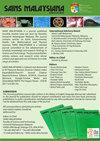Applications of Hydrocolloids and Its Effects on Physicochemical Characteristics of Gluten-free Bread from Corn and Rice Flour
IF 0.7
4区 综合性期刊
Q3 MULTIDISCIPLINARY SCIENCES
引用次数: 0
Abstract
Rice and corn flour can be used for gluten-free bread using a number of food hydrocolloids to improve the physicochemical properties closer to wheat products. This research aims to observe the effect of different types of food hydrocolloids, namely xanthan gum, glucomannan, carrageenan and CMC (Carboxymethyl Cellulose) on the physicochemical characteristics of gluten-free bread made from rice and corn flour. This research used a completely randomized design with two replications. This research observed the application of hydrocolloids to the formulation of gluten-free bread. The optimal increase in hydrocolloid concentration was determined to be 1 g for both CMC and carrageenan in both corn and rice flour. The highest addition of 1 g CMC in gluten-free bread made from corn flour, resulted in a specific volume of 3.422 cm3/g. The best gluten-free corn bread after drying contains a composition of 5.73% moisture content, 1.89% ash content, 17.34% fat content, 9.37% protein content, 65.67% carbohydrate content, and energy of 456.22 Kcal.水胶体的应用及其对玉米和大米面粉制成的无麸质面包理化特性的影响
大米和玉米粉可用于制作无麸质面包,使用一些食品亲水胶体可改善其理化特性,使其更接近小麦产品。本研究旨在观察不同类型的食品亲水胶体,即黄原胶、葡甘聚糖、卡拉胶和 CMC(羧甲基纤维素)对用大米和玉米粉制成的无筋面包的理化特性的影响。本研究采用完全随机设计,两次重复。该研究观察了水胶体在无麸质面包配方中的应用。在玉米粉和大米粉中,CMC 和卡拉胶的最佳水胶体浓度均为 1 克。在玉米粉制成的无麸质面包中,最高添加量为 1 克 CMC,比容为 3.422 立方厘米/克。烘干后的最佳无筋玉米面包的水分含量为 5.73%,灰分含量为 1.89%,脂肪含量为 17.34%,蛋白质含量为 9.37%,碳水化合物含量为 65.67%,能量为 456.22 千卡。
本文章由计算机程序翻译,如有差异,请以英文原文为准。
求助全文
约1分钟内获得全文
求助全文
来源期刊

Sains Malaysiana
MULTIDISCIPLINARY SCIENCES-
CiteScore
1.60
自引率
12.50%
发文量
196
审稿时长
3-6 weeks
期刊介绍:
Sains Malaysiana is a refereed journal committed to the advancement of scholarly knowledge and research findings of the several branches of science and technology. It contains articles on Earth Sciences, Health Sciences, Life Sciences, Mathematical Sciences and Physical Sciences. The journal publishes articles, reviews, and research notes whose content and approach are of interest to a wide range of scholars. Sains Malaysiana is published by the UKM Press an its autonomous Editorial Board are drawn from the Faculty of Science and Technology, Universiti Kebangsaan Malaysia. In addition, distinguished scholars from local and foreign universities are appointed to serve as advisory board members and referees.
 求助内容:
求助内容: 应助结果提醒方式:
应助结果提醒方式:


